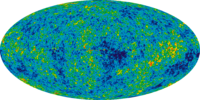
Photo from wikipedia
Reflectance anisotropy spectroscopy (RAS), which was originally invented to monitor epitaxial growth, can—as we have previously shown—also be used to monitor the reactive ion etching of III/V semiconductor samples in… Click to show full abstract
Reflectance anisotropy spectroscopy (RAS), which was originally invented to monitor epitaxial growth, can—as we have previously shown—also be used to monitor the reactive ion etching of III/V semiconductor samples in situ and in real time, as long as the etching rate is not too high and the abrasion at the etch front is not totally chaotic. Moreover, we have proven that—using RAS equipment and optical Fabry‒Perot oscillations due to the ever-shrinking thickness of the uppermost etched layer—the in situ etch-depth resolution can be as good as ±0.8 nm, employing a Vernier-scale type measurement and evaluation procedure. Nominally, this amounts to ±1.3 lattice constants in our exemplary material system, AlGaAsSb, on a GaAs or GaSb substrate. In this contribution, we show that resolutions of about ±5.6 nm can be reliably achieved without a Vernier scale protocol by employing thin doped layers or sharp interfaces between differently doped layers or quantum-dot (QD) layers as etch-stop indicators. These indicator layers can either be added to the device layer design on purpose or be part of it incidentally due to the functionality of the device. For typical etch rates in the range of 0.7 to 1.3 nm/s (that is, about 40 to 80 nm/min), the RAS spectrum will show a distinct change even for very thin indicator layers, which allows for the precise termination of the etch run.
Journal Title: Micromachines
Year Published: 2021
Link to full text (if available)
Share on Social Media: Sign Up to like & get
recommendations!